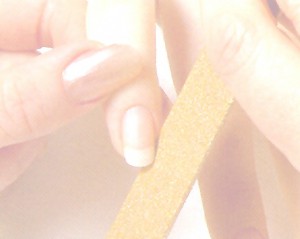The Basics
Contents

Many men tend to neglect their nails. They keep them trimmed for convenience as much as appearance, but that’s about it. There’s nothing effeminate about having healthy, strong, attractive nails, though, and they’re not hard to achieve.
Nails are basically dead protein, much like hair. They’re produced from the living nail bed (the pink you see through your nails), and their strength and structure are a direct reflection of your overall health and diet. Many nail problems like splitting, flaking, brittleness and ridges are attributable to poor eating habits.
Although it’s not an instant cure, you can strengthen your nails over a period of time by stirring an envelope of unflavoured gelatin into your morning glass of juice.
Although nails appear solid, they’re porous on a microscopic scale. It’s possible for nails to develop various infections, particularly when they’re not exposed to the air or to regular cleaning. Regular hand washing is sufficient to take care of most problems, but if you wear polish or false nails for long stretches you may be inviting trouble. And while we’re on the topic:
Cleansing
Wash your hands. Not only is it hygienically a good idea; it helps remoisturise them. Nails like this! Use a cold cream, preferably one with vitamin E in it, or a moisturiser like Keri Lotion or Vaseline Intensive Care Lotion frequently, to replace lost moisture and oils. This is absolutely vital if you use powerful hand cleaners at work; after all, they’re designed to remove grease and oil, aren’t they?
Dishpan hands? Gardening hands? Garage hands? Rubber gloves work really well, although we can’t recommend them as evening wear except in certain select circles. Just use them in the kitchen, honey.
Trimming
How long should your nails be? Healthy nails (on men and women) are usually about 1 – 2 mm past the quick (the pink part). Shape to match the outer end of the quick. Longer nails are more feminine but may attract attention at the office. If you grow them longer, shape them to match the luna (the light moon-shaped area at the base of the nail).
Nail clippers are convenient and fine for strong nails. Since they flatten out the nail while cutting, they can provoke splitting in heavily arched or weak nails. To remedy this, try smaller bites.
Nail scissors are easier on the nail as they don’t flatten it while cutting but require a certain ambidexterity. Best of all is a good emery board, or (in a pinch) a nail file. Even clippers and scissors should be followed by a touch-up with a fine file to remove snags.
Nail files are not all created equal. Cheapest – and hardest on your nail – is a metal file. Emery boards are better for your nails and still economical. Get one with at least a coarse and a fine side to it. Better still are those made from rigid foam. They provide a good blend between firmness and cushioning.
Do the rough shaping with the coarser side of the board, finishing up with the fine side. To prevent flaking, always stroke from the corner of the nail to the centre, never back and forth or up and down. Round off the edge to remove any snags lurking beneath.
The nail surface is more fragile than it looks. You may be tempted to file down ridges or buff them away. Be very careful! Nails are made up of layers and layers of protein. Filing down the ridges can lead to flaking, brittle nails as you break up the layers. If you must, file along the length of the ridge instead of across.
It goes without saying (yeah, but we’ll say it anyway) that clean fingernails look and feel better and are healthier. Stains from work, old nail polish and nicotine are a no-no. And biting your nails is best left to the cartoon characters.
Our next section deals with the fine art of The Manicure.
